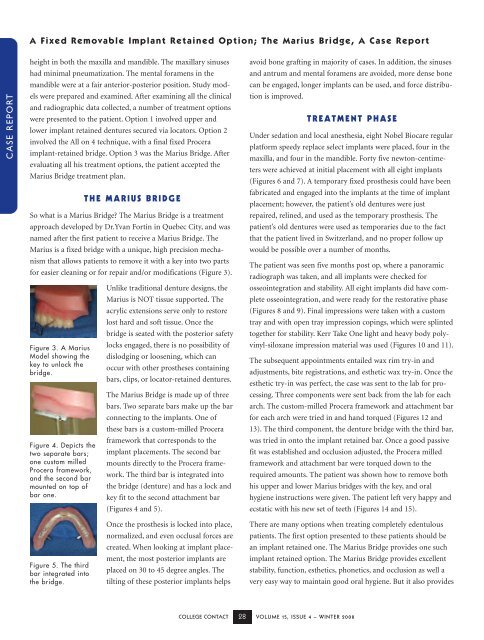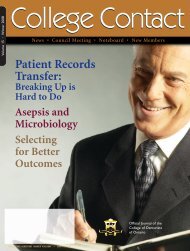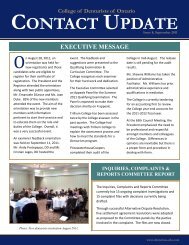College Contact
College Contact - Winter 2009 - College of Denturists of Ontario
College Contact - Winter 2009 - College of Denturists of Ontario
Create successful ePaper yourself
Turn your PDF publications into a flip-book with our unique Google optimized e-Paper software.
A Fixed Removable Implant Retained Option; The Marius Bridge, A Case Report<br />
CASE REPORT<br />
height in both the maxilla and mandible. The maxillary sinuses<br />
had minimal pneumatization. The mental foramens in the<br />
mandible were at a fair anterior-posterior position. Study models<br />
were prepared and examined. After examining all the clinical<br />
and radiographic data collected, a number of treatment options<br />
were presented to the patient. Option 1 involved upper and<br />
lower implant retained dentures secured via locators. Option 2<br />
involved the All on 4 technique, with a final fixed Procera<br />
implant-retained bridge. Option 3 was the Marius Bridge. After<br />
evaluating all his treatment options, the patient accepted the<br />
Marius Bridge treatment plan.<br />
THE MARIUS BRIDGE<br />
So what is a Marius Bridge? The Marius Bridge is a treatment<br />
approach developed by Dr.Yvan Fortin in Quebec City, and was<br />
named after the first patient to receive a Marius Bridge. The<br />
Marius is a fixed bridge with a unique, high precision mechanism<br />
that allows patients to remove it with a key into two parts<br />
for easier cleaning or for repair and/or modifications (Figure 3).<br />
Figure 3. A Marius<br />
Model showing the<br />
key to unlock the<br />
bridge.<br />
Figure 4. Depicts the<br />
two separate bars;<br />
one custom milled<br />
Procera framework,<br />
and the second bar<br />
mounted on top of<br />
bar one.<br />
Unlike traditional denture designs, the<br />
Marius is NOT tissue supported. The<br />
acrylic extensions serve only to restore<br />
lost hard and soft tissue. Once the<br />
bridge is seated with the posterior safety<br />
locks engaged, there is no possibility of<br />
dislodging or loosening, which can<br />
occur with other prostheses containing<br />
bars, clips, or locator-retained dentures.<br />
The Marius Bridge is made up of three<br />
bars. Two separate bars make up the bar<br />
connecting to the implants. One of<br />
these bars is a custom-milled Procera<br />
framework that corresponds to the<br />
implant placements. The second bar<br />
mounts directly to the Procera framework.<br />
The third bar is integrated into<br />
the bridge (denture) and has a lock and<br />
key fit to the second attachment bar<br />
(Figures 4 and 5).<br />
avoid bone grafting in majority of cases. In addition, the sinuses<br />
and antrum and mental foramens are avoided, more dense bone<br />
can be engaged, longer implants can be used, and force distribution<br />
is improved.<br />
TREATMENT PHASE<br />
Under sedation and local anesthesia, eight Nobel Biocare regular<br />
platform speedy replace select implants were placed, four in the<br />
maxilla, and four in the mandible. Forty five newton-centimeters<br />
were achieved at initial placement with all eight implants<br />
(Figures 6 and 7). A temporary fixed prosthesis could have been<br />
fabricated and engaged into the implants at the time of implant<br />
placement; however, the patient’s old dentures were just<br />
repaired, relined, and used as the temporary prosthesis. The<br />
patient’s old dentures were used as temporaries due to the fact<br />
that the patient lived in Switzerland, and no proper follow up<br />
would be possible over a number of months.<br />
The patient was seen five months post op, where a panoramic<br />
radiograph was taken, and all implants were checked for<br />
osseointegration and stability. All eight implants did have complete<br />
osseointegration, and were ready for the restorative phase<br />
(Figures 8 and 9). Final impressions were taken with a custom<br />
tray and with open tray impression copings, which were splinted<br />
together for stability. Kerr Take One light and heavy body polyvinyl-siloxane<br />
impression material was used (Figures 10 and 11).<br />
The subsequent appointments entailed wax rim try-in and<br />
adjustments, bite registrations, and esthetic wax try-in. Once the<br />
esthetic try-in was perfect, the case was sent to the lab for processing.<br />
Three components were sent back from the lab for each<br />
arch. The custom-milled Procera framework and attachment bar<br />
for each arch were tried in and hand torqued (Figures 12 and<br />
13). The third component, the denture bridge with the third bar,<br />
was tried in onto the implant retained bar. Once a good passive<br />
fit was established and occlusion adjusted, the Procera milled<br />
framework and attachment bar were torqued down to the<br />
required amounts. The patient was shown how to remove both<br />
his upper and lower Marius bridges with the key, and oral<br />
hygiene instructions were given. The patient left very happy and<br />
ecstatic with his new set of teeth (Figures 14 and 15).<br />
Figure 5. The third<br />
bar integrated into<br />
the bridge.<br />
Once the prosthesis is locked into place,<br />
normalized, and even occlusal forces are<br />
created. When looking at implant placement,<br />
the most posterior implants are<br />
placed on 30 to 45 degree angles. The<br />
tilting of these posterior implants helps<br />
There are many options when treating completely edentulous<br />
patients. The first option presented to these patients should be<br />
an implant retained one. The Marius Bridge provides one such<br />
implant retained option. The Marius Bridge provides excellent<br />
stability, function, esthetics, phonetics, and occlusion as well a<br />
very easy way to maintain good oral hygiene. But it also provides<br />
COLLEGE CONTACT 28 VOLUME 15, ISSUE 4 – WINTER 2008




